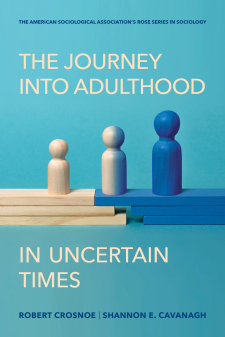Main navigation
Blog
Consumer Finance Special Issue: Journal of Marketing Research
 Late last year, we announced the release of a special issue on consumer finance from the Journal of Marketing Research. The issue, funded by the Russell Sage and Alfred P. Sloan Foundations, features 14 articlesthat provide new insights on how to improve consumers' financial decisions. We previewed some of the articles in these blog posts, but now, we have received permission to post the entire issue for free. Browse through the links and abstracts below to download the papers.
Late last year, we announced the release of a special issue on consumer finance from the Journal of Marketing Research. The issue, funded by the Russell Sage and Alfred P. Sloan Foundations, features 14 articlesthat provide new insights on how to improve consumers' financial decisions. We previewed some of the articles in these blog posts, but now, we have received permission to post the entire issue for free. Browse through the links and abstracts below to download the papers.
Misunderstanding Savings Growth: Implications for Retirement Savings Behavior
Authors: Craig R.M. McKenzie and Michael J. Liersch
Abstract: People systematically underestimate exponential growth. This article illustrates this phenomenon, its implications, and some potential interventions in the context of saving for retirement, where savings grow exponentially over long periods of time. Experiment 1 shows that a majority of participants expect savings over 40 years to grow linearly rather than exponentially, leading them to grossly underestimate their account balance at retirement. Experiment 2 demonstrates that this misunderstanding leads to underestimates of the cost of waiting to save, which makes putting off saving more attractive than it should be. Finally, Experiments 3-5 show that highlighting the exponential growth of savings motivates both college students and employees to save more for retirement. Making clear to employees the exponential growth of savings before they make crucial decisions about how much to save may be a simple and effective means of increasing retirement savings.
Earmaking and Partitioning: Increasing Saving by Low-Income Households
Authors: Dilip Soman and Amar Cheema
Abstract: This research examines the effects of earmarking money on savings by low-income consumers. In particular, the authors test two interventions that are designed to enhance the effects of earmarking: a) using a visual reminder of the savings goal and b) dividing the earmarked money into two parts. Consistent with prior research which suggests that partitioning increases self-control, individuals save more when earmarked money is partitioned into two accounts versus pooled in one account. In addition, the presence of the visual reminder increases the savings rate. The authors conclude with implications for consumers’ welfare and a discussion of directions for further research.
Increasing Saving Behavior Through Age-Progressed Renderings of the Future Self
Authors: Hal E. Hershfield, Daniel G. Goldstein, William F. Sharpe, Jesse Fox, Leo Yeykelis, Laura L. Carstensen, and Jeremy N. Bailenson
Abstract: Many people fail to save what they will need for retirement. Research on excessive discounting of the future suggests that removing the lure of immediate rewards by precommitting to decisions or elaborating the value of future rewards both can make decisions more future oriented. The authors explore a third and complementary route, one that deals not with present and future rewards but with present and future selves. In line with research that shows that people may fail, because of a lack of belief or imagination, to identify with their future selves, the authors propose that allowing people to interact with age-progressed renderings of themselves will cause them to allocate more resources to the future. In four studies, participants interacted with realistic computer renderings of their future selves using immersive virtual reality hardware and interactive decision aids. In all cases, those who interacted with their virtual future selves exhibited an increased tendency to accept later monetary rewards over immediate ones.
Winning the Battle but Losing the War: The Psychology of Debt Management
Authors: Moty Amar, Dan Ariely, Shahar Ayal, Cynthia E. Cryder, and Scott I. Rick
Abstract: When consumers carry multiple debts, how do they decide which debt to repay first? Normatively, consumers should repay the debt with the highest interest rate most quickly. However, because people tend to break complicated tasks into more manageable parts, and because losses are most distressing when segregated, we hypothesized that people would pay off the smallest loan first to reduce the total number of outstanding loans and achieve a sense of tangible progress toward debt repayment. To experimentally examine how consumers manage multiple debts, we developed an incentive-compatible debt management game, in which participants were saddled with multiple debts and decided how to repay them over time. Consistent with our hypothesis, four experiments revealed evidence of debt account aversion: Participants consistently paid off small debts first, even though the larger debts had higher interest rates. We also found that restricting participants’ ability to completely pay off small debts, and focusing their attention on the amount of interest each debt has accumulated, helped them reduce overall debt more quickly.
Using Loan Plus Lender Literacy Information to Combat One-Sided Marketing of Debt Consolidation Loans
Authors: Lisa E. Bolton, Paul N. Bloom, and Joel B. Cohen
Abstract: The marketing of debt consolidation loans is intended to offer a financial remedy to consumers faced with mounting debt and credit problems and unable to meet their monthly payments. The authors argue that debt consolidation loan marketing overemphasizes the short-term benefits (e.g., lower monthly payments) and downplays the considerable downside of these loans (e.g., longer repayment and more total interest paid). Two experiments demonstrate that a financial literacy intervention combining information about loans and lenders can help consumers understand and respond to debt consolidation loan marketing (whereas a basic financial numeracy intervention does not). Implications for consumers, marketers, public policy makers, and researchers who work in the area of financial literacy are discussed.
Minimum Required Payment and Supplemental Information Disclosure Effects on Consumer Debt Repayment Decisions
Authors: Daniel Navarro-Martinez, Linda Court Salisbury, Katherine N. Lemon, Neil Stewart, William J. Matthews, and Adam J.L. Harris
Abstract: Repayment decisions—how much of the loan to repay and when to make the payments—directly influence consumer debt levels. The authors examine how minimum required payment policy and loan information disclosed to consumers influence repayment decisions. They find that while presenting minimum required payment information has a negative impact on repayment decisions, increasing the minimum required level has a positive effect on repayment for most consumers. Experimental evidence from U.S. consumers shows that consumers' propensity to pay the minimum required each month moderates these effects; U.K. credit card field data indicate that borrowers' credit limit and balance due also moderate these effects. However, increasing the minimum level is unlikely to completely eliminate the negative effect of presenting minimum payment information. In addition, disclosing supplemental information, such as future interest cost and time needed to repay the loan, does not reduce the negative effects of including minimum payment information and has no substantial positive effect on repayments. This research offers new insights into the debt repayment process and has implications for consumers, lenders, and public policy.
Leave Home Without It? The Effects of Credit Card Debt and Available Credit on Spending
Authors: Keith Wilcox, Lauren G. Block, and Eric M. Eisenstein
Abstract: This research examines how credit card debt affects consumer spending. In five experimental and field studies, the authors demonstrate that outstanding credit card debt increases spending for consumers with high self-control. They also show that this effect can be eliminated by increasing the available credit on the credit card. Thus, when the available credit is low, consumers with greater self-control increase spending, but when the available credit is high, they reduce spending. The results extend the literature on goal violation and self-control and offer insights into consumer decision making and consumption patterns under conditions of debt.
Axe the Tax: Taxes Are Disliked More than Equivalent Costs
Authors: Abigail B. Sussman and Christopher Y. Olivola
Abstract: Tax collection is critical for the proper functioning of society. However, many people strongly dislike paying taxes. Although this distaste could be rational on economic grounds, the authors show that this attitude extends beyond simply disliking the costs incurred and affects behavior in counternormative ways. They demonstrate the phenomenon of tax aversion: a desire to avoid taxes per se that exceeds the rational economic motivation to avoid a monetary cost. Across five experiments, the authors provide evidence that people have a stronger preference to avoid tax-related costs than to avoid equal-sized (or larger) monetary costs unrelated to taxes. Tax aversion affects consumer preferences in a variety of domains, including standard store purchases, financial investments, and job selection. Furthermore, this tendency is most prevalent among people who identify with political parties that generally favor less taxation. Finally, encouraging participants who identify with “antitax” parties to consider positive uses of their tax payments mitigates tax aversion. This article concludes with a discussion of the implications of these results for consumer behavior research and tax policies.
Once Burned, Twice Shy: How Naive Learning, Counterfactuals, and Regret Affect the Repurchase of Stocks Previously Sold
Authors: Michal Ann Strahilevitz, Terrance Odean, and Brad M. Barber
Abstract: Investors' previous experiences with a stock affect their willingness to repurchase that stock. Using detailed trade data from two brokers, the authors document that investors are reluctant to repurchase stocks previously sold for a loss and stocks that have risen in price subsequent to a prior sale. The authors propose that this behavior reflects investors' emotional reactions to trading and their attempts to distance themselves from negative emotions (e.g., disappointment, regret). Investors are disappointed when they sell a stock for a loss and regret having ever purchased the stock; these negative emotions deter investors from later repurchasing stocks they sold for a loss. Having sold a stock, investors are disappointed if the stock continues to rise and regret having sold the stock in the first place; these negative emotions deter investors from repurchasing stocks that go up since being sold. Thus, investors engage in reinforcement learning by repurchasing stocks whose previous purchase resulted in positive emotions and avoiding stocks whose previous purchase resulted in negative emotions.
Fear, Social Projection, and Financial Decision Making
Authors: Chan Jean Lee and Eduardo B. Andrade
Abstract: The number of individual investors who trade stocks online has significantly increased in recent years. Surprisingly, consumer researchers have paid little attention to how emotions influence individual investors' stock-trading decisions. In a series of three experiments, the authors investigate the impact of incidental fear on the decision to sell in a stock market simulation. The results show that fearful (vs. control) participants sell their stock earlier (Experiments 1–3). This effect, however, is contingent on particular features of the market. Fear leads to early sell-off when partipant believe the value of the stock is peer generated but not when they believe the value of the stock is computer generated (Experiment 2). Early sell-off as a result of incidental fear also occurs when participants believe their risk attitude is common in the market but not when they believe their risk attitude is unique (Experiment 3). Social projection—that is, people's tendency to rely on their current state of mind to estimate other people's actions—explains the phenomenon.
Microfinance Decision Making: A Field Study of Prosocial Lending
Authors: Jeff Galak, Deborah Small, and Andrew T. Stephen
Abstract: Microfinancing, or small uncollateralized loans to entrepreneurs in the developing world, has recently emerged as a leading contender to cure world poverty. Our research investigates the characteristics of borrowers that engender lending through Kiva, a popular organization that connects individual lenders to borrowers through online microfinance. Lenders favor individual borrowers over groups or consortia of borrowers, a pattern consistent with the identifiable victim effect. They also favor borrowers that are socially proximate to themselves. Across three dimensions of social distance (gender, occupation, and first name initial), lenders prefer to give to those who are more like themselves.
Tell Me a Good Story and I May Lend You Money: The Role of Narratives in Peer-to-Peer Lending Decisions
Authors: Michal Herzenstein, Scott Sonenshein, and Utpal M. Dholakia
Abstract: This research examines how identity claims constructed in narratives by borrowers influence lender decisions about unsecured personal loans. Specifically, do the number of identity claims and their content influence lending decisions, and can they predict the longer-term performance of funded loans? Using data from the peer-to-peer lending website Prosper.com, the authors find that unverifiable information affects lending decisions above and beyond the influence of objective, verifiable information. As the number of identity claims in narratives increases, so does loan funding, whereas loan performance suffers, because these borrowers are less likely to pay back the loan. In addition, identity content plays an important role. Identities focused on being trustworthy or successful are associated with increased loan funding but ironically are less predictive of loan performance than other identities (i.e., moral and economic hardship). Thus, some identity claims aim to mislead lenders, whereas others provide true representations of borrowers.
Marketing Complex Financial Products in Emerging Markets: Evidence from Rainfall Insurance in India
Authors: Sarthak Gaurav, Shawn Cole, and Jeremy Tobacman
Abstract: Recent financial liberalization in emerging economies has led to the rapid introduction of new financial products. Lack of experience with financial products, low levels of education, and low financial literacy may slow adoption of these products. This article reports on a field experiment that offered an innovative new financial product, rainfall insurance, to 600 small-scale farmers in India. A customized financial literacy and insurance education module communicating the need for personal financial management and the usefulness of formal hedging of agricultural production risks was offered to randomly selected farmers in Gujarat, India. The authors evaluate the effect of the financial literacy training and three marketing treatments using a randomized controlled trial. Financial education has a positive and significant effect on rainfall insurance adoption, increasing take-up from 8% to 16%. Only one marketing intervention, the money-back guarantee, has a consistent and large effect on farmers' purchase decisions. This guarantee, comparable to a price reduction of approximately 40%, increases demand by seven percentage points.
Are Consumers Too Trusting? The Effects of Relationships with Expert Advisers
Authors: Janet Schwartz, Mary Frances Luce, and Dan Ariely
Abstract: Many important and complex consumer decisions rely on the advice of trusted professional experts. Many experts, however, such as doctors, financial advisers, and accountants, may be prone to conflicts of interest. As such, consumers may seek a second opinion. A series of studies investigate consumers' reluctance to seek additional advice in the context of having an ongoing relationship with one expert service provider. The authors find evidence in health care claims that long-term relationships contribute to more expensive, but not necessarily better, treatment. In addition, a series of experiments show that people recognize when they could benefit from a second opinion but are more reluctant to do so when thinking about their own providers rather than someone else's. Further studies test a relationship maintenance hypothesis and show that consumers' reluctance to seek second opinions is partially driven by their motivation to preserve relationship harmony, even when it is at their own personal expense and well-being. Taken together, these results provide important insight into the potential limitations and consequences of longstanding relationships between consumers and experts.





